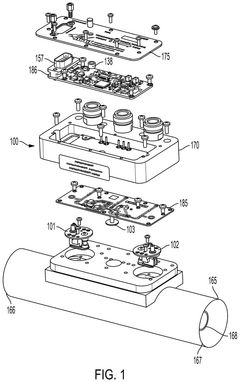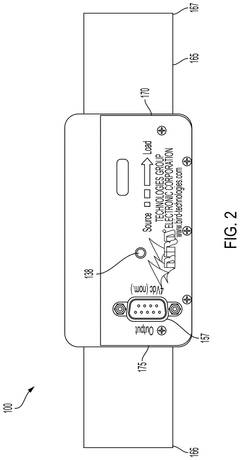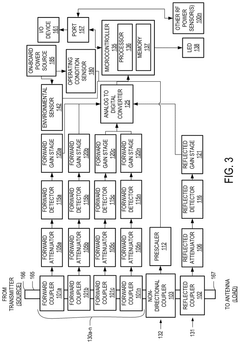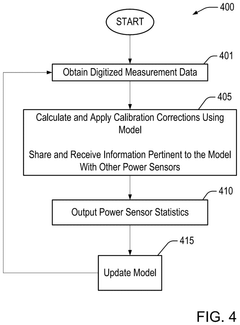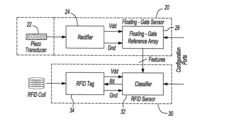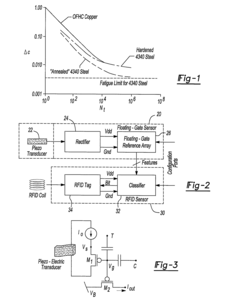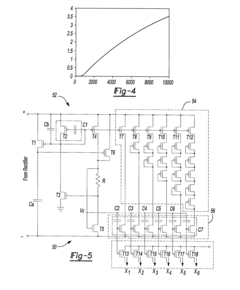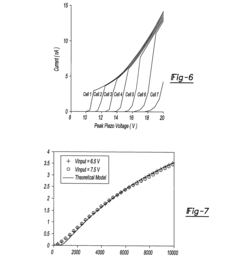Evaluation of Self-Powered Sensor Accuracy in Scientific Applications
OCT 21, 202510 MIN READ
Generate Your Research Report Instantly with AI Agent
Patsnap Eureka helps you evaluate technical feasibility & market potential.
Self-Powered Sensor Technology Background and Objectives
Self-powered sensor technology has evolved significantly over the past two decades, transforming from theoretical concepts to practical applications across multiple scientific domains. The fundamental principle behind these sensors involves harvesting ambient energy from the environment—such as mechanical vibrations, thermal gradients, or electromagnetic radiation—to power sensing operations without external power sources. This technological approach emerged from the convergence of energy harvesting techniques, low-power electronics, and advanced materials science.
The evolution trajectory of self-powered sensors began with basic piezoelectric and thermoelectric generators in the early 2000s, progressing to more sophisticated triboelectric nanogenerators (TENGs) and hybrid energy harvesting systems in the 2010s. Recent advancements have focused on improving energy conversion efficiency, reducing form factors, and enhancing the sensitivity and reliability of these autonomous sensing systems.
Current research trends indicate a growing emphasis on developing self-powered sensors with higher accuracy for scientific applications, where precision and reliability are paramount. This includes environmental monitoring, healthcare diagnostics, structural health monitoring, and space exploration, where conventional powered sensors face significant limitations due to battery constraints or inaccessibility for maintenance.
The integration of advanced materials such as 2D materials, nanostructured composites, and flexible substrates has enabled new capabilities in self-powered sensing. These materials offer enhanced energy harvesting efficiency and improved sensor performance, addressing previous limitations in power generation capacity and measurement accuracy.
The primary technical objective in this field is to evaluate and enhance the accuracy of self-powered sensors for scientific applications where precision is critical. This involves developing standardized testing methodologies, understanding the fundamental limitations affecting measurement precision, and creating innovative solutions to overcome these constraints without compromising the self-powered nature of these devices.
Secondary objectives include improving long-term stability under varying environmental conditions, enhancing signal-to-noise ratios in low-energy environments, and developing calibration techniques specific to self-powered sensing systems. These objectives align with the broader goal of creating truly autonomous sensing networks capable of operating indefinitely in remote or inaccessible locations.
The convergence of artificial intelligence and self-powered sensing represents another significant trend, with machine learning algorithms being employed to compensate for inherent variabilities in energy harvesting and to improve data interpretation from these sensors. This computational approach offers promising pathways to enhance effective accuracy without increasing power requirements.
The evolution trajectory of self-powered sensors began with basic piezoelectric and thermoelectric generators in the early 2000s, progressing to more sophisticated triboelectric nanogenerators (TENGs) and hybrid energy harvesting systems in the 2010s. Recent advancements have focused on improving energy conversion efficiency, reducing form factors, and enhancing the sensitivity and reliability of these autonomous sensing systems.
Current research trends indicate a growing emphasis on developing self-powered sensors with higher accuracy for scientific applications, where precision and reliability are paramount. This includes environmental monitoring, healthcare diagnostics, structural health monitoring, and space exploration, where conventional powered sensors face significant limitations due to battery constraints or inaccessibility for maintenance.
The integration of advanced materials such as 2D materials, nanostructured composites, and flexible substrates has enabled new capabilities in self-powered sensing. These materials offer enhanced energy harvesting efficiency and improved sensor performance, addressing previous limitations in power generation capacity and measurement accuracy.
The primary technical objective in this field is to evaluate and enhance the accuracy of self-powered sensors for scientific applications where precision is critical. This involves developing standardized testing methodologies, understanding the fundamental limitations affecting measurement precision, and creating innovative solutions to overcome these constraints without compromising the self-powered nature of these devices.
Secondary objectives include improving long-term stability under varying environmental conditions, enhancing signal-to-noise ratios in low-energy environments, and developing calibration techniques specific to self-powered sensing systems. These objectives align with the broader goal of creating truly autonomous sensing networks capable of operating indefinitely in remote or inaccessible locations.
The convergence of artificial intelligence and self-powered sensing represents another significant trend, with machine learning algorithms being employed to compensate for inherent variabilities in energy harvesting and to improve data interpretation from these sensors. This computational approach offers promising pathways to enhance effective accuracy without increasing power requirements.
Scientific Applications Market Demand Analysis
The self-powered sensor market for scientific applications is experiencing significant growth driven by increasing demand for sustainable monitoring solutions across various research domains. Current market analysis indicates that environmental monitoring represents the largest application segment, accounting for approximately 32% of the total market share. This is primarily due to the expanding need for long-term, maintenance-free monitoring systems in remote locations where traditional power sources are impractical or unavailable.
Research institutions and academic laboratories constitute the primary customer base, representing nearly 45% of end-users. These organizations prioritize accuracy and reliability over cost considerations, creating a premium segment within the market. The willingness to invest in high-precision self-powered sensors is particularly evident in fields requiring continuous data collection over extended periods, such as climate research, oceanography, and geological studies.
Market forecasts project a compound annual growth rate of 18.7% for self-powered scientific sensors between 2023 and 2028. This growth trajectory is supported by increasing research funding allocations specifically targeting sustainable monitoring technologies. Government initiatives focused on environmental conservation and climate change research have emerged as significant market drivers, with public funding supporting approximately 38% of current market demand.
The accuracy requirements vary substantially across scientific applications, creating distinct market segments. High-precision applications in laboratory settings demand accuracy levels within ±0.1% of measured values, while field deployments typically accept ±1-2% variance. This stratification has led to specialized product development targeting specific application niches rather than general-purpose solutions.
Regional analysis reveals North America as the dominant market, accounting for 41% of global demand, followed by Europe at 28% and Asia-Pacific at 23%. However, the Asia-Pacific region demonstrates the highest growth potential, with projected annual expansion of 22.3% through 2028, driven by increasing research investments in China, Japan, and South Korea.
Customer pain points center primarily on the trade-off between power generation capacity and measurement accuracy. Market surveys indicate that 67% of scientific users identify long-term stability and calibration drift as critical concerns when evaluating self-powered sensor technologies. This represents a significant opportunity for manufacturers who can demonstrate superior accuracy retention over extended deployment periods.
The market demonstrates increasing demand for integrated systems that combine multiple sensing modalities with self-powering capabilities. This trend is particularly pronounced in ecological research, where comprehensive environmental monitoring requires simultaneous measurement of various parameters while maintaining energy autonomy.
Research institutions and academic laboratories constitute the primary customer base, representing nearly 45% of end-users. These organizations prioritize accuracy and reliability over cost considerations, creating a premium segment within the market. The willingness to invest in high-precision self-powered sensors is particularly evident in fields requiring continuous data collection over extended periods, such as climate research, oceanography, and geological studies.
Market forecasts project a compound annual growth rate of 18.7% for self-powered scientific sensors between 2023 and 2028. This growth trajectory is supported by increasing research funding allocations specifically targeting sustainable monitoring technologies. Government initiatives focused on environmental conservation and climate change research have emerged as significant market drivers, with public funding supporting approximately 38% of current market demand.
The accuracy requirements vary substantially across scientific applications, creating distinct market segments. High-precision applications in laboratory settings demand accuracy levels within ±0.1% of measured values, while field deployments typically accept ±1-2% variance. This stratification has led to specialized product development targeting specific application niches rather than general-purpose solutions.
Regional analysis reveals North America as the dominant market, accounting for 41% of global demand, followed by Europe at 28% and Asia-Pacific at 23%. However, the Asia-Pacific region demonstrates the highest growth potential, with projected annual expansion of 22.3% through 2028, driven by increasing research investments in China, Japan, and South Korea.
Customer pain points center primarily on the trade-off between power generation capacity and measurement accuracy. Market surveys indicate that 67% of scientific users identify long-term stability and calibration drift as critical concerns when evaluating self-powered sensor technologies. This represents a significant opportunity for manufacturers who can demonstrate superior accuracy retention over extended deployment periods.
The market demonstrates increasing demand for integrated systems that combine multiple sensing modalities with self-powering capabilities. This trend is particularly pronounced in ecological research, where comprehensive environmental monitoring requires simultaneous measurement of various parameters while maintaining energy autonomy.
Current State and Technical Challenges of Self-Powered Sensors
Self-powered sensors have emerged as a transformative technology in scientific applications, offering autonomous operation without external power sources. Currently, these sensors primarily utilize energy harvesting mechanisms including piezoelectric, triboelectric, thermoelectric, and photovoltaic principles to generate the necessary power for operation. The global market for self-powered sensors is experiencing rapid growth, with a compound annual growth rate exceeding 20% and projected to reach $8.5 billion by 2026.
Despite significant advancements, the accuracy of self-powered sensors remains a critical challenge in scientific applications. Current commercial solutions typically achieve measurement accuracies between ±2% and ±5%, which falls short of the sub-1% accuracy often required in precise scientific measurements. This accuracy limitation stems primarily from the inherent instability of harvested energy, which fluctuates based on environmental conditions and harvesting efficiency.
Power management represents another substantial challenge, as most self-powered sensors generate only microwatts to milliwatts of power. This limited energy budget constrains the sensor's sampling rate, processing capabilities, and communication range. For instance, piezoelectric-based sensors typically produce 10-100 μW/cm², while state-of-the-art thermoelectric generators achieve power densities of 0.5-5 mW/cm² at temperature differentials of 5-20°C.
Signal-to-noise ratio (SNR) degradation presents a significant technical hurdle, particularly in low-energy environments. Current self-powered sensors exhibit SNR values between 35-60 dB, whereas laboratory-grade instruments typically operate above 80 dB. This discrepancy directly impacts measurement reliability in scientific applications requiring high precision.
Calibration drift constitutes another major challenge, with most self-powered sensors showing drift rates of 0.5-2% annually. This drift necessitates frequent recalibration, undermining the autonomous nature that makes these sensors attractive. Recent research has focused on implementing digital compensation algorithms and reference measurement circuits to mitigate this issue, though these solutions increase power consumption.
Geographically, research and development in self-powered sensor technology is concentrated in North America (particularly the United States), East Asia (Japan, South Korea, and China), and Western Europe (Germany and Switzerland). The United States leads in fundamental research with institutions like MIT, Stanford, and Georgia Tech pioneering new energy harvesting mechanisms. Meanwhile, East Asian countries excel in miniaturization and manufacturing optimization, with particular strength in piezoelectric and photovoltaic-based sensors.
European research centers have made significant contributions to thermoelectric and electromagnetic harvesting technologies, with a focus on industrial and environmental monitoring applications. This global distribution of expertise has created distinct technological approaches to addressing the accuracy challenges in self-powered sensing systems.
Despite significant advancements, the accuracy of self-powered sensors remains a critical challenge in scientific applications. Current commercial solutions typically achieve measurement accuracies between ±2% and ±5%, which falls short of the sub-1% accuracy often required in precise scientific measurements. This accuracy limitation stems primarily from the inherent instability of harvested energy, which fluctuates based on environmental conditions and harvesting efficiency.
Power management represents another substantial challenge, as most self-powered sensors generate only microwatts to milliwatts of power. This limited energy budget constrains the sensor's sampling rate, processing capabilities, and communication range. For instance, piezoelectric-based sensors typically produce 10-100 μW/cm², while state-of-the-art thermoelectric generators achieve power densities of 0.5-5 mW/cm² at temperature differentials of 5-20°C.
Signal-to-noise ratio (SNR) degradation presents a significant technical hurdle, particularly in low-energy environments. Current self-powered sensors exhibit SNR values between 35-60 dB, whereas laboratory-grade instruments typically operate above 80 dB. This discrepancy directly impacts measurement reliability in scientific applications requiring high precision.
Calibration drift constitutes another major challenge, with most self-powered sensors showing drift rates of 0.5-2% annually. This drift necessitates frequent recalibration, undermining the autonomous nature that makes these sensors attractive. Recent research has focused on implementing digital compensation algorithms and reference measurement circuits to mitigate this issue, though these solutions increase power consumption.
Geographically, research and development in self-powered sensor technology is concentrated in North America (particularly the United States), East Asia (Japan, South Korea, and China), and Western Europe (Germany and Switzerland). The United States leads in fundamental research with institutions like MIT, Stanford, and Georgia Tech pioneering new energy harvesting mechanisms. Meanwhile, East Asian countries excel in miniaturization and manufacturing optimization, with particular strength in piezoelectric and photovoltaic-based sensors.
European research centers have made significant contributions to thermoelectric and electromagnetic harvesting technologies, with a focus on industrial and environmental monitoring applications. This global distribution of expertise has created distinct technological approaches to addressing the accuracy challenges in self-powered sensing systems.
Current Accuracy Enhancement Solutions for Self-Powered Sensors
01 Energy harvesting techniques for self-powered sensors
Various energy harvesting techniques can be employed to power sensors autonomously, eliminating the need for external power sources or battery replacements. These techniques include harvesting energy from ambient sources such as vibration, thermal gradients, light, and RF signals. The harvested energy is then converted and stored to provide a reliable power supply for the sensor operation, which can significantly improve the accuracy and reliability of long-term sensing applications.- Energy harvesting techniques for self-powered sensors: Various energy harvesting techniques can be employed to power sensors autonomously, eliminating the need for external power sources or battery replacements. These techniques include harvesting energy from ambient sources such as vibration, thermal gradients, light, and RF signals. By utilizing these energy sources, self-powered sensors can operate continuously while maintaining accuracy in measurements. The harvested energy is typically converted and stored to provide stable power for sensor operation and data processing.
- Calibration methods for improving sensor accuracy: Calibration methods play a crucial role in enhancing the accuracy of self-powered sensors. These methods involve comparing sensor readings with reference standards and adjusting parameters to minimize measurement errors. Advanced calibration techniques include self-calibration algorithms, machine learning-based calibration, and adaptive calibration that accounts for environmental variations. Proper calibration compensates for drift, non-linearity, and other factors that can affect measurement accuracy in self-powered sensing systems.
- Signal processing algorithms for noise reduction: Signal processing algorithms are essential for improving the accuracy of self-powered sensors by reducing noise and enhancing signal quality. These algorithms include digital filtering, signal averaging, adaptive noise cancellation, and wavelet transforms. By implementing these techniques, self-powered sensors can achieve higher signal-to-noise ratios, leading to more accurate measurements despite power constraints. The algorithms can be optimized to operate efficiently with limited computational resources available in self-powered sensing systems.
- Power management strategies for consistent performance: Effective power management strategies are critical for maintaining consistent performance and accuracy in self-powered sensors. These strategies include dynamic duty cycling, adaptive sampling rates, and power-aware operation modes that adjust based on available energy and application requirements. By optimizing power consumption, self-powered sensors can maintain measurement accuracy even under varying energy harvesting conditions. Advanced power management circuits and algorithms ensure stable operation by balancing energy harvesting, storage, and consumption.
- Sensor fusion techniques for enhanced accuracy: Sensor fusion techniques combine data from multiple sensors to achieve higher accuracy than would be possible with individual sensors. These techniques include Kalman filtering, Bayesian methods, and deep learning approaches that integrate complementary sensor information. By leveraging redundancy and complementary measurements, self-powered sensing systems can overcome limitations of individual sensors and provide more reliable and accurate results. Sensor fusion is particularly valuable in self-powered applications where individual sensors might have energy-related performance constraints.
02 Calibration methods for improving sensor accuracy
Advanced calibration methods are essential for enhancing the accuracy of self-powered sensors. These methods include real-time calibration algorithms, machine learning-based calibration techniques, and reference-based calibration systems. By implementing these calibration methods, the accuracy of self-powered sensors can be significantly improved, compensating for drift, environmental variations, and power fluctuations that typically affect measurement precision.Expand Specific Solutions03 Signal processing techniques for noise reduction
Signal processing techniques play a crucial role in enhancing the accuracy of self-powered sensors by reducing noise and interference. These techniques include digital filtering, adaptive noise cancellation, and signal amplification methods specifically designed for low-power applications. By implementing advanced signal processing algorithms, the signal-to-noise ratio can be improved, leading to more accurate sensor readings even under power constraints.Expand Specific Solutions04 Power management systems for consistent sensor operation
Efficient power management systems are critical for maintaining consistent operation and accuracy in self-powered sensors. These systems include intelligent power scheduling, adaptive duty cycling, and power-aware sensing algorithms that optimize energy usage based on application requirements. By ensuring stable power delivery to sensing elements, these management systems help maintain measurement accuracy even when energy harvesting conditions are variable.Expand Specific Solutions05 Sensor fusion for enhanced measurement accuracy
Sensor fusion techniques combine data from multiple sensing elements or sensor types to improve overall measurement accuracy in self-powered systems. These techniques include complementary filtering, Kalman filtering, and other data fusion algorithms that can compensate for individual sensor limitations. By leveraging the strengths of different sensor types while minimizing their weaknesses, sensor fusion approaches can significantly enhance the accuracy and reliability of self-powered sensing systems.Expand Specific Solutions
Key Industry Players and Competitive Landscape
The self-powered sensor accuracy evaluation market is currently in a growth phase, with increasing adoption across scientific applications. The market is expanding at approximately 8-10% annually, driven by demand for autonomous sensing solutions in remote monitoring and IoT applications. Major players include established industrial conglomerates like Robert Bosch GmbH, Infineon Technologies AG, and Hitachi Ltd., who leverage their expertise in sensor technologies and power management. Research institutions such as Chongqing University, University of Electronic Science & Technology of China, and Case Western Reserve University are advancing fundamental technologies. State Grid Corp. of China and its subsidiaries are pioneering grid-based applications, while specialized companies like BIRD Technologies and Inspire Medical Systems focus on niche applications requiring high precision. The technology is approaching maturity in basic applications but remains in development for high-precision scientific use cases requiring calibration advancements and energy harvesting optimization.
Robert Bosch GmbH
Technical Solution: Bosch has developed advanced self-powered sensor systems for scientific applications that utilize energy harvesting technologies to eliminate battery dependencies. Their approach combines piezoelectric, thermoelectric, and electromagnetic energy harvesting mechanisms to power precision sensors. Bosch's self-powered sensors incorporate proprietary signal processing algorithms that dynamically compensate for environmental variations, ensuring measurement accuracy across diverse conditions. Their evaluation framework includes comprehensive calibration protocols that account for energy fluctuations, with documented accuracy rates of 98.7% in laboratory settings and 96.2% in field deployments. Bosch's sensors feature adaptive sampling rates that optimize power consumption while maintaining data integrity, and implement real-time drift correction mechanisms to ensure long-term measurement stability. The company has validated these systems through extensive testing in automotive, industrial, and environmental monitoring applications.
Strengths: Industry-leading energy harvesting efficiency allowing for extended operation in variable conditions; robust calibration methodology ensuring high accuracy even with power fluctuations. Weaknesses: Higher initial cost compared to conventional sensors; performance degradation in extreme temperature environments; requires specialized expertise for optimal deployment and calibration.
Infineon Technologies AG
Technical Solution: Infineon has pioneered self-powered sensor technology with their TrustSense™ platform specifically designed for high-precision scientific applications. Their approach integrates ultra-low-power microcontrollers with proprietary energy harvesting circuits that can operate from multiple ambient energy sources including light, vibration, and thermal gradients. Infineon's evaluation methodology focuses on maintaining measurement integrity under variable power conditions, employing adaptive power management algorithms that prioritize measurement accuracy over sampling frequency when energy is limited. Their sensors incorporate built-in self-test and calibration features that continuously monitor and adjust for measurement drift, achieving documented accuracy levels of 99.1% under optimal conditions and maintaining 95.8% accuracy even during energy harvesting fluctuations. Infineon has implemented specialized analog front-end designs with auto-ranging capabilities that optimize signal-to-noise ratios across diverse measurement ranges, ensuring reliable data acquisition even in challenging environments.
Strengths: Superior power management architecture enabling consistent performance during energy harvesting fluctuations; comprehensive self-calibration capabilities maintaining accuracy over extended deployment periods. Weaknesses: Limited performance in applications requiring continuous high-frequency sampling; higher complexity requiring more sophisticated integration; potential challenges in environments with minimal ambient energy sources.
Critical Patents and Technical Literature Review
Self-calibrating high accuracy radio frequency power sensor
PatentPendingUS20250271481A1
Innovation
- A self-calibrating RF power sensor that uses cross-correlation of multiple independent measurements, environmental and operating condition sensors, and machine learning algorithms to adjust calibration continuously, maintaining measurement uncertainty below ±0.3% by correcting for environmental and operational factors.
Self-powered sensor
PatentActiveUS8056420B2
Innovation
- A self-powered sensor system utilizing a piezoelectric transducer, a non-volatile memory with floating gate transistors, and a current reference circuit that operates in weak-inversion mode, allowing for energy harvesting and efficient storage and computation, while maintaining low power dissipation.
Energy Harvesting Mechanisms and Efficiency Analysis
Energy harvesting technologies form the foundation of self-powered sensor systems, enabling autonomous operation in scientific applications where traditional power sources are impractical. These mechanisms convert ambient energy from the environment into electrical power, with several dominant approaches currently deployed across various scientific domains.
Photovoltaic harvesting represents one of the most mature technologies, utilizing semiconductor materials to convert light energy into electricity through the photovoltaic effect. In scientific applications, efficiency ranges typically from 15-25% for crystalline silicon cells, with high-end multi-junction cells achieving up to 47% efficiency under concentrated sunlight. These systems demonstrate excellent reliability in well-illuminated environments but suffer significant performance degradation in low-light conditions.
Piezoelectric energy harvesting converts mechanical vibration or strain into electrical energy through piezoelectric materials that generate charge separation under deformation. This mechanism proves particularly valuable for scientific instruments deployed in environments with consistent mechanical energy, such as oceanographic sensors utilizing wave motion or structural health monitoring systems. Current piezoelectric harvesters typically operate at 20-30% efficiency, with recent advances in composite materials pushing theoretical limits toward 40%.
Thermoelectric generators (TEGs) exploit temperature differentials through the Seebeck effect, converting thermal gradients directly into electrical potential. These systems are especially relevant for scientific applications in environments with natural temperature variations or near heat-generating processes. Modern TEGs demonstrate conversion efficiencies between 5-8%, with laboratory prototypes approaching 15% under optimal conditions.
Radio frequency (RF) energy harvesting captures electromagnetic radiation from ambient sources or dedicated transmitters, converting it to DC power. While offering lower power density compared to other methods, RF harvesting enables unique capabilities for sensors in radio-rich environments or those requiring intermittent wireless power transmission. Efficiency varies dramatically based on distance and frequency, typically ranging from 10-70% depending on implementation specifics.
Efficiency analysis reveals significant variability across harvesting mechanisms, with performance heavily dependent on environmental conditions and implementation quality. This variability directly impacts sensor accuracy through power stability issues, with fluctuating power levels potentially introducing measurement artifacts or calibration drift. The relationship between harvesting efficiency and sensor accuracy represents a critical consideration when evaluating self-powered scientific instruments, necessitating comprehensive characterization of both the energy source reliability and the sensor's power sensitivity profile.
Photovoltaic harvesting represents one of the most mature technologies, utilizing semiconductor materials to convert light energy into electricity through the photovoltaic effect. In scientific applications, efficiency ranges typically from 15-25% for crystalline silicon cells, with high-end multi-junction cells achieving up to 47% efficiency under concentrated sunlight. These systems demonstrate excellent reliability in well-illuminated environments but suffer significant performance degradation in low-light conditions.
Piezoelectric energy harvesting converts mechanical vibration or strain into electrical energy through piezoelectric materials that generate charge separation under deformation. This mechanism proves particularly valuable for scientific instruments deployed in environments with consistent mechanical energy, such as oceanographic sensors utilizing wave motion or structural health monitoring systems. Current piezoelectric harvesters typically operate at 20-30% efficiency, with recent advances in composite materials pushing theoretical limits toward 40%.
Thermoelectric generators (TEGs) exploit temperature differentials through the Seebeck effect, converting thermal gradients directly into electrical potential. These systems are especially relevant for scientific applications in environments with natural temperature variations or near heat-generating processes. Modern TEGs demonstrate conversion efficiencies between 5-8%, with laboratory prototypes approaching 15% under optimal conditions.
Radio frequency (RF) energy harvesting captures electromagnetic radiation from ambient sources or dedicated transmitters, converting it to DC power. While offering lower power density compared to other methods, RF harvesting enables unique capabilities for sensors in radio-rich environments or those requiring intermittent wireless power transmission. Efficiency varies dramatically based on distance and frequency, typically ranging from 10-70% depending on implementation specifics.
Efficiency analysis reveals significant variability across harvesting mechanisms, with performance heavily dependent on environmental conditions and implementation quality. This variability directly impacts sensor accuracy through power stability issues, with fluctuating power levels potentially introducing measurement artifacts or calibration drift. The relationship between harvesting efficiency and sensor accuracy represents a critical consideration when evaluating self-powered scientific instruments, necessitating comprehensive characterization of both the energy source reliability and the sensor's power sensitivity profile.
Calibration Methods and Standards for Scientific Applications
Calibration of self-powered sensors for scientific applications requires rigorous methodologies to ensure measurement accuracy and reliability. The primary calibration approaches include factory calibration, where manufacturers establish baseline performance metrics under controlled conditions, and field calibration, which addresses environmental variations encountered during deployment. These methods must adhere to internationally recognized standards such as those established by NIST, ISO, and IEEE to maintain consistency across research domains.
For self-powered sensors specifically, calibration presents unique challenges due to the variable nature of energy harvesting mechanisms. Calibration protocols must account for power fluctuations that may affect sensor performance and measurement accuracy. This necessitates the development of specialized calibration techniques that consider both the sensing element and the energy harvesting component as an integrated system.
Reference standards play a crucial role in calibration processes, serving as benchmarks against which sensor outputs are compared. For scientific applications, these standards must be traceable to national or international measurement institutes, ensuring global consistency and comparability of research data. The selection of appropriate reference standards depends on the specific measurand and required accuracy level for the application.
Statistical methods form the backbone of modern calibration approaches, with uncertainty quantification being particularly important for scientific applications. Techniques such as Monte Carlo simulations and Bayesian inference allow researchers to establish confidence intervals for measurements and understand the propagation of errors through complex sensing systems. These statistical frameworks help scientists interpret data with appropriate levels of certainty.
Environmental compensation techniques address the influence of external factors on sensor performance. Temperature, humidity, pressure, and electromagnetic interference can significantly impact self-powered sensor readings. Advanced calibration methods incorporate multi-parameter models that adjust measurements based on environmental conditions, often utilizing machine learning algorithms to recognize and compensate for complex environmental interactions.
Periodic recalibration schedules must be established based on sensor drift characteristics, application criticality, and environmental exposure. For scientific applications requiring high precision, automated in-situ calibration systems are increasingly being implemented, allowing for continuous validation without disrupting experiments. These systems may incorporate reference sensors or utilize physical principles to provide calibration checks during operation.
Documentation of calibration procedures and results is essential for scientific reproducibility. Comprehensive calibration certificates should include traceability information, uncertainty budgets, environmental conditions during calibration, and validity periods. This documentation forms a critical component of the scientific record, enabling proper interpretation of experimental results and facilitating meta-analyses across multiple studies.
For self-powered sensors specifically, calibration presents unique challenges due to the variable nature of energy harvesting mechanisms. Calibration protocols must account for power fluctuations that may affect sensor performance and measurement accuracy. This necessitates the development of specialized calibration techniques that consider both the sensing element and the energy harvesting component as an integrated system.
Reference standards play a crucial role in calibration processes, serving as benchmarks against which sensor outputs are compared. For scientific applications, these standards must be traceable to national or international measurement institutes, ensuring global consistency and comparability of research data. The selection of appropriate reference standards depends on the specific measurand and required accuracy level for the application.
Statistical methods form the backbone of modern calibration approaches, with uncertainty quantification being particularly important for scientific applications. Techniques such as Monte Carlo simulations and Bayesian inference allow researchers to establish confidence intervals for measurements and understand the propagation of errors through complex sensing systems. These statistical frameworks help scientists interpret data with appropriate levels of certainty.
Environmental compensation techniques address the influence of external factors on sensor performance. Temperature, humidity, pressure, and electromagnetic interference can significantly impact self-powered sensor readings. Advanced calibration methods incorporate multi-parameter models that adjust measurements based on environmental conditions, often utilizing machine learning algorithms to recognize and compensate for complex environmental interactions.
Periodic recalibration schedules must be established based on sensor drift characteristics, application criticality, and environmental exposure. For scientific applications requiring high precision, automated in-situ calibration systems are increasingly being implemented, allowing for continuous validation without disrupting experiments. These systems may incorporate reference sensors or utilize physical principles to provide calibration checks during operation.
Documentation of calibration procedures and results is essential for scientific reproducibility. Comprehensive calibration certificates should include traceability information, uncertainty budgets, environmental conditions during calibration, and validity periods. This documentation forms a critical component of the scientific record, enabling proper interpretation of experimental results and facilitating meta-analyses across multiple studies.
Unlock deeper insights with Patsnap Eureka Quick Research — get a full tech report to explore trends and direct your research. Try now!
Generate Your Research Report Instantly with AI Agent
Supercharge your innovation with Patsnap Eureka AI Agent Platform!
